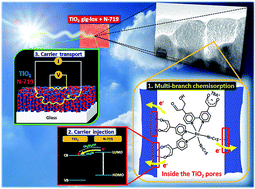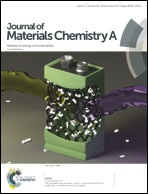Pervasive infiltration and multi-branch chemisorption of N-719 molecules into newly designed spongy TiO2 layers deposited by gig-lox sputtering processes†
Abstract
The use of nanostructured materials represents a breakthrough in many fields of applications owing to their enhanced functionalities. In this framework, newly designed spongy TiO2 layers are deposited by a reactive sputtering method based on a grazing-incidence geometry combined with the local oxidation of the species (gig-lox). The deposited material gains 50% porosity in volume through depths of hundreds of nanometers and consists of a forest of uniform rods separated by meso-pores (pipelines for dye diffusion) arising from the grazing geometry; the rods, on their side, have an internal branched structure creating an interconnected network of nano-pores with sizes in the 3–5 nm range. The gig-lox TiO2 layer, sensitised with a standard Ru-complex (N-719), is tested as a scaffold for dye chemisorption and charge injection/collection. We demonstrate that the interconnected array of pores allows a deep and pervasive infiltration of the dye through the whole layer with a density of 1–2 × 1020 molecules per cm3. A second advantage is represented by the nano-pore size that, being similar to the steric hindrance of the dye, allows the N-719 molecules to establish a multi-branch (octopus) anchoring on the pore walls. Using CH3CN instead of CH3CH2OH as the solvent increases the probability of octopus chemisorption due to a more proper interaction with the dye. As an overall effect, we measure an increment of the electron density in the conduction band of the gig-lox TiO2 layer of 4 orders of magnitude under 1 sun illumination with respect to the intrinsic carrier level. This finding gives positive feedback on the injection efficiency, related to the dye density, distribution and anchoring, and also on the carrier collection capability of the gig-lox TiO2 owing to the existence of a percolation path for the current to cross the whole material. All these properties afford good practical prospects for photo-active hybrid blends based on industrially up-scalable solvent-free TiO2 gig-lox scaffolds to exploit their many structural advantages for DSCs and similar architectures.



 Please wait while we load your content...
Please wait while we load your content...